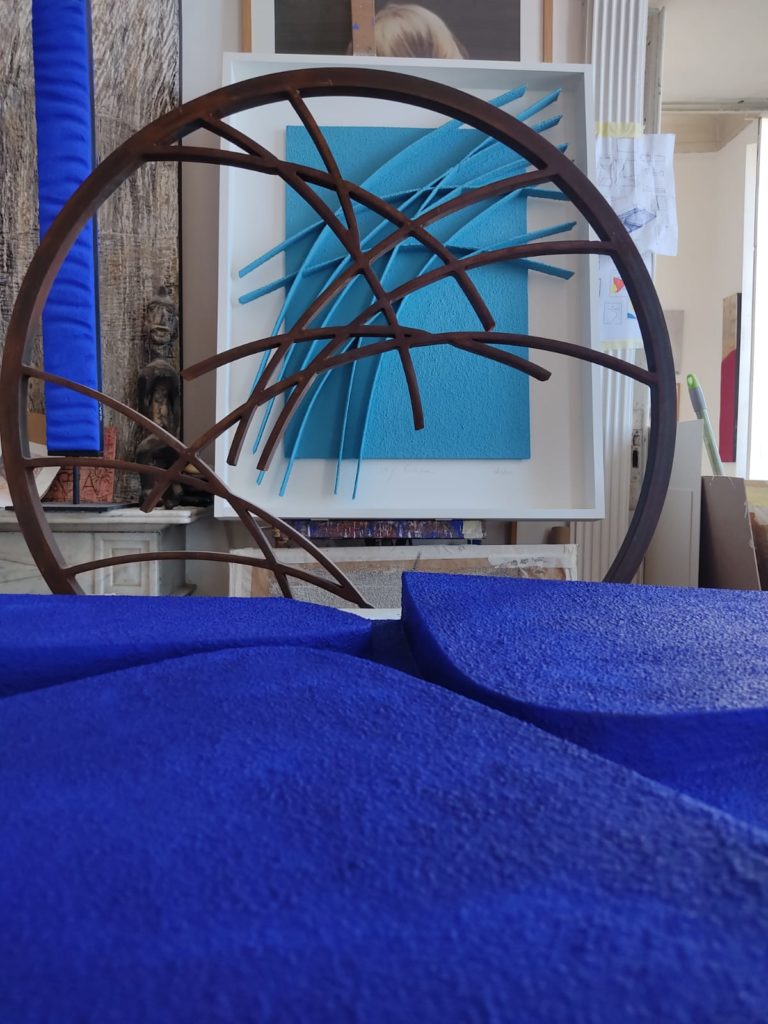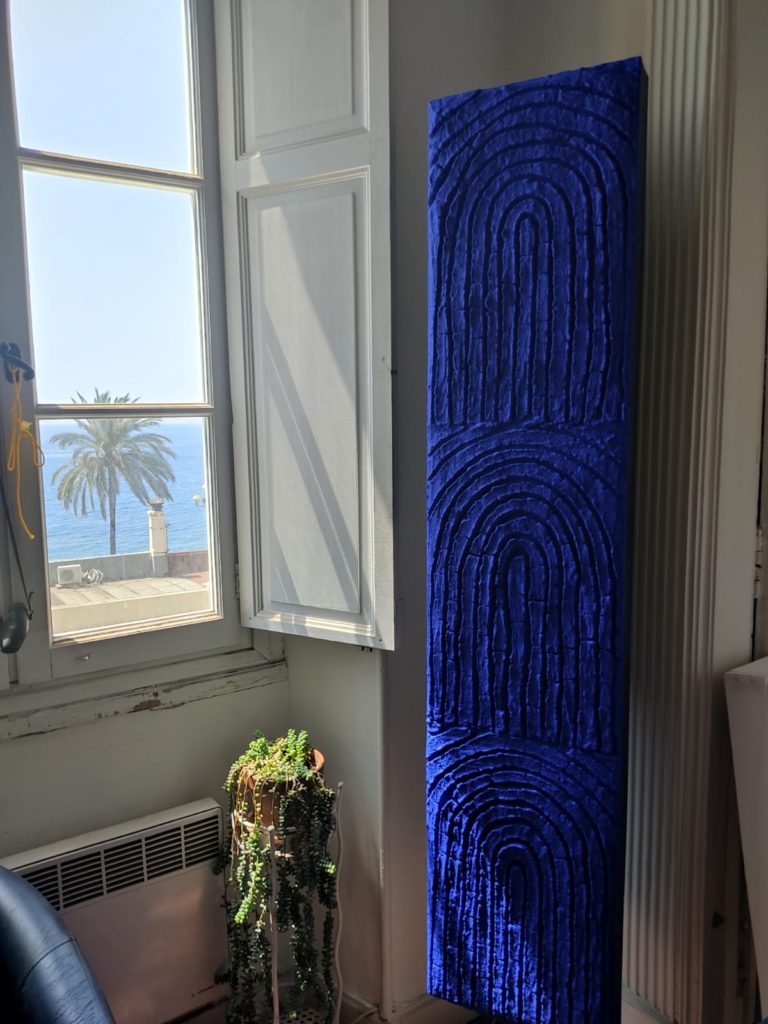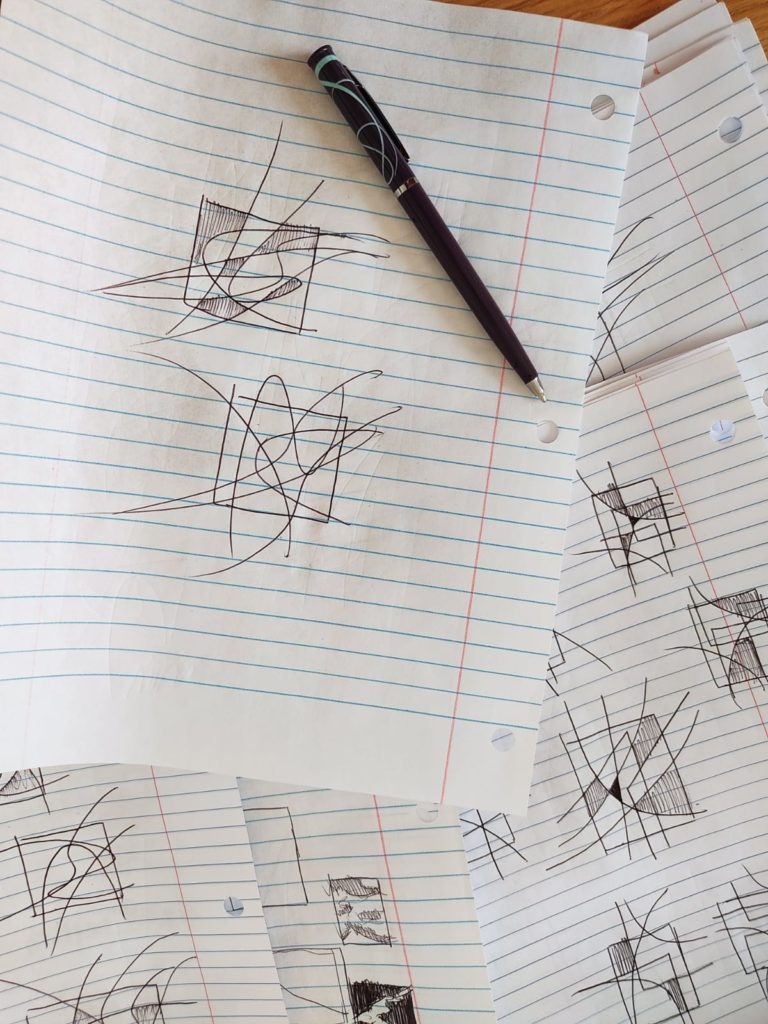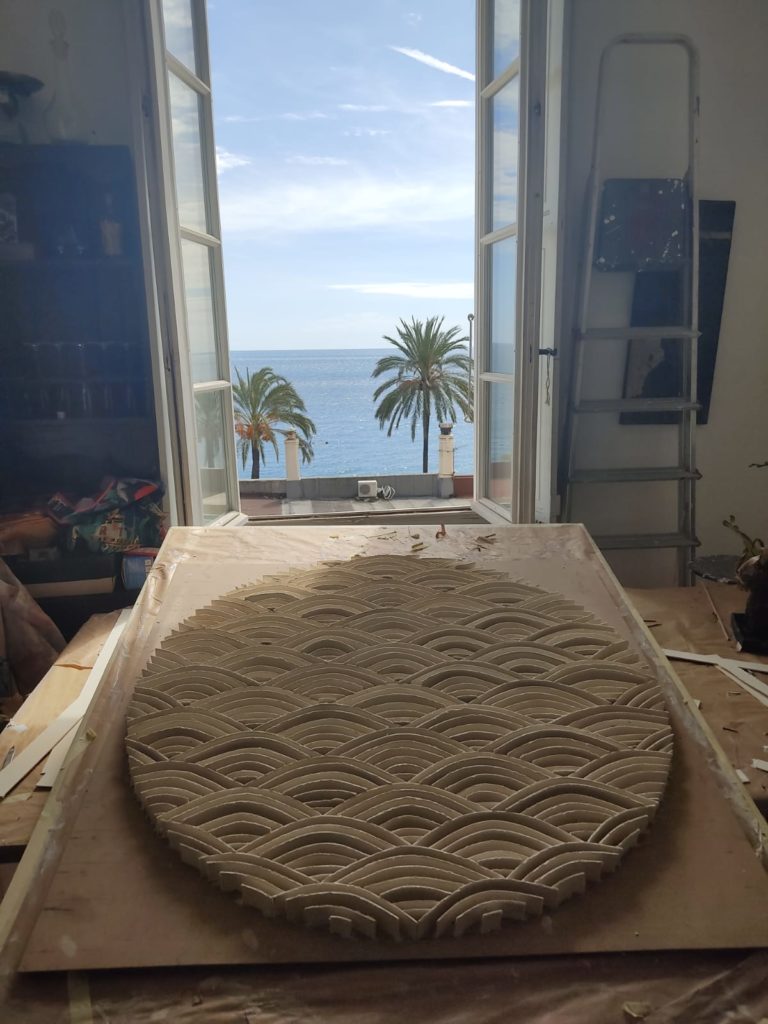Artiste incontournable de la galerie, René Galassi nous ouvre les portes de son atelier à Nice, ville qui l’inspire depuis de nombreuses années, du bleu profond de la Méditerranée au couleurs chaudes de la vieille ville.
Bonjour René, Peux-tu te présenter ?
Bonjour, Je m’appelle René Galassi, je suis artiste plasticien. Je vis et travaille à Nice. Je viens du monde du papier. Il y a plus de 30 ans, j’ai intégré un atelier d’art de gravure sur papier, en tant que taille-doucier, dans lequel j’ai imprimé un grand nombre d’œuvres de différents peintres (reconnus ou non dans la région). Au bout de 4/5 ans, je suis passée de l’autre côté et ai créé mes propres gravures. Elles ont fonctionné rapidement, et je me suis donc lancé dans le travail d’artiste plasticien.
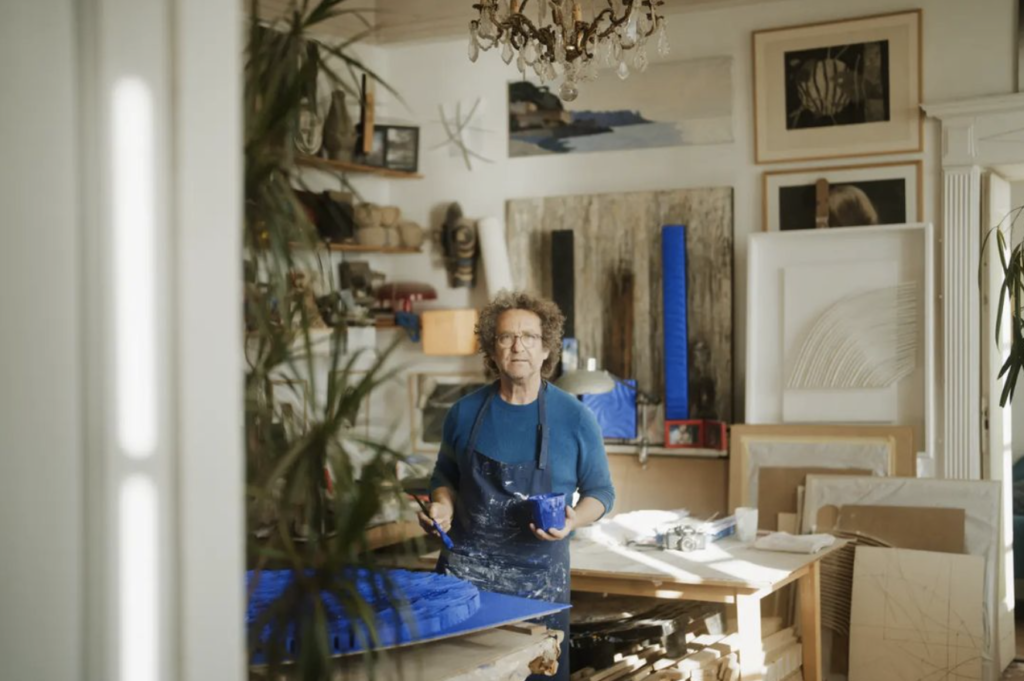
Comment t’exprimes-tu en tant qu’artiste ?
Tout mon travail tourne autour de la gravure, même si ça n’a pas forcément de lien direct visible. Si je fais des œuvres originales, c’est grâce et par le biais du papier et de la gravure. Si je n’avais pas été graveur, je n’aurais jamais pu réaliser les œuvres que je crée actuellement, car lorsque l’on imprime une gravure, on choisit le format de l’image, mais il nous reste toujours des chutes de papier, des bandes plus spécifiquement.
Le papier que l’on utilise dans la gravure est un papier que j’adore, qui s’appelle le papier chiffon, réalisé à la main. J’ai conservé toutes ces chutes de papier, pendant des années sans jamais les jeter, sans savoir qu’un jour j’allais les réutiliser. C’est en imprimant des traces de cordes sur des papiers que j’ai eu l’idée de les utiliser, de façon détournée.
Je les utilise désormais perpendiculaire à un support, pour créer mon travail actuel, la série Calicots et pigments.
Et parallèlement à ma gravure, j’ai toujours travaillé le pigment. Pendant plus de 15 ans, j’ai cherché à fixer le pigment sans le dénaturer. Pour ce faire, j’ai axé mes œuvres sur des couleurs qui ne sont que des couleurs primaires (à savoir le rouge, le jaune et le bleu). Ensuite je me suis concentré sur le fait de restituer la même intensité de lumière, sur mes œuvres, que lorsque l’on voit les pigments purs. Ce n’est pas un produit que l’on achète dans le commerce. C’est une cuisine que l’on fabrique. Quand on est taille-doucier, on est devant la plaque à imprimer des œuvres toute la journée, donc on observe la matière et la couleur. Le soir, quand on ferme les yeux, on revoit l’impression des couleurs. C’est comme une photographie. Il était donc pour moi important de travailler la couleur et que celle-ci soit présente dans mes œuvres.
Quel est ton procédé créatif ?
J’ai des périodes de plusieurs mois, pendant lesquels tous les matins, comme un musicien qui fait ses gammes, je vais réaliser des dizaines et des dizaines de croquis. Je vais donc passer une heure/une heure et demie tous les jours à dessiner des croquis. Je vais en sélectionner quelques-uns. Et pour moi, la création est vraiment là.
Ensuite, une fois que j’ai déterminé le graphisme que je vais réaliser, cela devient de l’artisanat d’art. la créativité est vraiment à la base.
Donc je prépare le support, car il n’existe pas dans le commerce. Je fais donc une structure soit en bois, soit en papier. Suivant la taille du tableau.
Ensuite je vais reproduire le petit dessin qui fait 2,3 cm de haut, et 1,5 cm de large, sur un format nettement plus grand. Déjà on change d’echelle, et parfois en changeant d’échelle, cela ne fonctionne plus, car ce qui est petit n’est pas forcément réalisable en grand. Tous les peintres le savent.
Si mon croquis fonctionne je prépare mes bandes de papiers, et les positionne sur mon tableau, je les colle, je sable l’œuvre, ou non en fonction de l’effet que je veux avoir.
Enfin je peins. Cela peut être très long, il y a beaucoup de temps de séchage. Cela peut durer plusieurs jours, la peinture dans mes œuvres est un travail très complexe. Il faut donc faire de nombreuses reprises. Mais une fois cette étape finie l’œuvre est terminée.
Il m’arrive donc de faire plusieurs tableaux en même temps, car quand une œuvre est en train de sécher, je peux intervenir sur une autre. Une œuvre, entre le temps de la penser et de la réaliser, il faut à minima 3 semaines.
Que cherches-tu à représenter dans tes œuvres ?
Tout doucement je me suis senti glissé vers cette volonté de représenter des choses strictes, même mes empreintes sont très déterminées à l’avance. J’aime aller à l’essentiel, y compris dans la création. Ce sont des empreintes de cordes, ou encore des formes géométriques. Je suis arrivé au point où j’avais envie d’aller. Je ne suis pas comme ça dans ma tête, mais c’est cette direction que j’ai envie de prendre, à savoir la structure bien déterminée.
D’ailleurs, je me rappelle qu’enfant, j’avais tendance à détruire tous les dessins que je réalisais, donc quelque part, j’essaye de sortir de ce chaos qui est présent dans ma vie de tous les jours, et d’arriver à quelque chose de très finalisé dans mes œuvres.
Ce qui m’intéresse c’est de réaliser de belle chose. Je suis à la recherche de la beauté, n’en déplaise à ceux qui pensent que l’art n’est pas là pour la représenter. Je suis très sensible à l’harmonie dans l’univers. Il y a une règle mathématique qui s’appelle la suite Fibonacci. C’est la meilleure approximation du nombre d’or, qui est présente partout dans la nature. La beauté s’explique par des mathématiques, et quelque part sans le savoir, j’ai rejoint cette suite.
Quelles sont tes sources d’inspiration ?
Au début j’étais très sensible à la matière. On peut nommer Antoni Tapies par exemple. Peut-être j’ai essayé de faire un peu comme lui au début, mais je n’ai pas réussi. Quelque part, il est allé au bout dans ce que l’on pouvait faire dans cette expérimentation. Donc j’ai quitté cet univers pour aller dans un mouvement qui me correspondait plus. Je pense donc que je suis influencé par un certain nombre de peintres, mais sans tout le temps le savoir et les nommer. Il y a par exemple Sol LeWitt qui est un artiste que j’aime beaucoup. Lorsque je l’ai découvert, je faisais un travail qui se rapprochait de ce qu’il faisait, en tout cas qui aurait pu être dans un univers proche. Donc au fur et à mesure je découvre des artistes qui exprime la même chose que moi, ce qui est sympa, mais en même temps dangereux. Car ce qui m’intéresse c’est de réaliser des choses qui me sont personnelles. Par exemple, j’aime les couleurs primaires et l’artistes qui est le plus connu dans l’utilisation des couleurs primaires, c’est Mondrian. On m’a donc souvent dit que je m’inspirai des couleurs de Mondrian, mais en fait, j’aime les valeurs du blanc et du noir, j’aime les couleurs primaires.
Découvrez toutes ses œuvres en cliquant ici !
